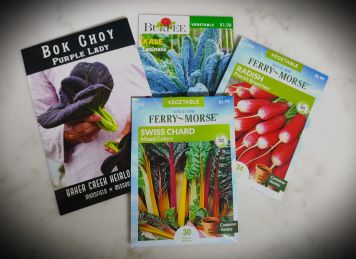
Last Chance Vegetable Seed Sowing
Return to Vegetables Agent Articles
With autumn around the corner, it may be hard to believe that certain vegetable crops can still be sown into the garden. The beginning of September is the last opportunity to sow many leafy vegetable greens, including lettuce, spinach, kale, and Bok choy, for a fall harvest.
Being a cold-tolerant cool-weather crop, leaf, or bib-type lettuce (as opposed to head lettuce) can thrive in a traditional fall climate that is not unseasonably warm or cold. Many lettuce varieties are prone to bolting and developing a bitter flavor with hot temperatures. The fall season will assist in avoiding both. Other common lettuce concerns, such as tip burn and aphids, are also less likely since cooler weather decreases their occurrence.
Spinach is one of the most cool-tolerant greens that can go into a vegetable garden. Planting it in the fall, you will have the added benefit of carrying the crop to spring if you lightly mulch over it in November. When uncovered in the spring, the spinach will thrive, have a well-established root system, and produce an ample yield as you selectively clip the largest leaves from the plants.
Depending on the variety of kale, desirable edible leaf production can also continue well throughout the warm season, as this cabbage relative is very hardy and can withstand both warmer and colder temperatures. Planted now, the crop can be expected to continue producing until nearly December or until we see the first extreme freeze of the year.
Bok choy is an often-overlooked cool season crop that will produce late into the fall, with the caveat that hotter temperatures can cause poor flavor or bolting. With a leaf usable in salads and an edible stem like celery it can be an asset to a fall garden harvest.
And it isn’t only leafy vegetables that can still be planted in September. Radish and turnips, root crops, may also still be established.
Monikered as “spring type” radishes, this type of radish is the same kind that can be replanted in September. Remember that with radish, hot and dry weather or insufficient watering will likely result in a very strong flavor, so the crop quality will also depend largely on the weather.
There is also a type of radish known as a “fall type.” Contrary to the spring type, these should have been planted in August and won’t be able to reach maturity for a harvest this far into the growing season.
Finally, turnips may also be planted in September, and turn out a harvest through to December. As with the others, watch the temperature they’re growing in, as heat can make them develop a woody texture and undesirable flavor.
Whether it be a leaf or root crop, your vegetable gardens don’t have to be done for the year if you don’t want them to be.
Anthony Reardon, Horticulture and Small Farms Agent, 2023
Return to Vegetables Agent Articles
Have questions?
The Garden Hotline is staffed by trained EMG volunteers and Extension staff who will assist you with questions.
Phone: (913) 715-7050
Email: garden.help@jocogov.org